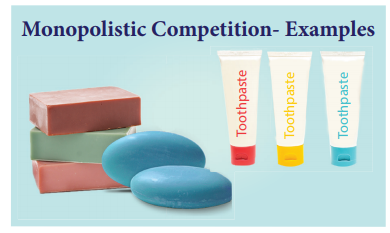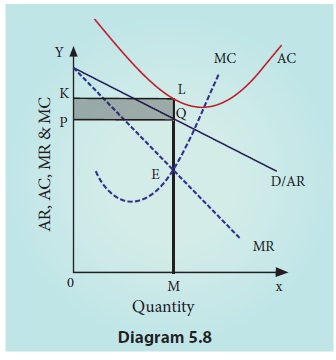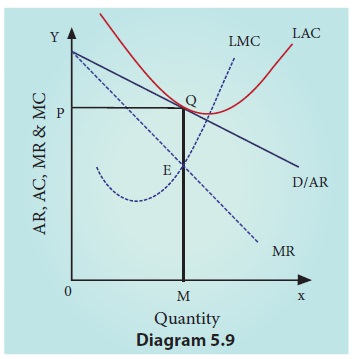Economics - Monopolistic Competition | 11th Economics : Chapter 5 : Market Structure and Pricing
Chapter: 11th Economics : Chapter 5 : Market Structure and Pricing
Monopolistic Competition
Monopolistic
Competition
Monopolistic
competition refers to a market situation where there are many firms selling a
differentiated product. There is competition which is keen,

No firm can have
any perceptible influence on the price-output policies of the other sellers nor
can it be influenced much by their actions. Thus monopolistic competition
refers to competition among a large number of sellers producing close but not
perfect substitutes for each other.
1. Features of monopolistic competition
The
important features of monopolistic competition are :
i.
There are large number of buyers and many sellers.
ii.
Firms under monopolistic competition are price
makers. They set their own prices.
iii.
Firms produce differentiated products. It is the
key element of monopolistic competition.
iv.
There is a free entry and exit of firms.
v.
Firms compete with each other by incurring selling
cost or expenditure on sales promotion of their products.
vi.
Non – price competition is an essential part of
monopolistic competition.
vii.
A firm can follow an independent price policy.
2. Price and Output Determination under Monopolistic Competition
The firm
under monopolistic competition achieves its equilibrium when it’s MC = MR, and
when its MC curve cuts its MR curve from below. If MC is less than MR, the
sellers will find it profitable to expand their output.
Under
monopolistic competition
1.
The demand curve is downwards sloping.
2.
There are close substitutes.
3.
The demand curve (the average revenue curve) is
fairly elastic.
Under
monopolistic competition, different firms produce different varieties of the
product and sell them at different prices. Each firm under monopolistic
competition seeks to achieve equilibrium as regards
1. Price
and output, 2. Product adjustment and 3. selling cost adjustment.
Short-run equilibrium:
How does
a monopolistically competitive firm achieve price-output level equilibrium? The
profit maximisation is achieved when MC=MR.

‘OM’ is
the equilibrium output. ‘OP’ is the equilibrium price. The total revenue is
‘OMQP’. And the total cost is ‘OMRS’. Therefore, total profit is ‘PQRS’. This
is super normal profit under short-run.
But under
differing revenue and cost conditions, the monopolistically competitive firms
many incur loss.

As shown
in the diagram, the AR and MR curves are fairly elastic. The equilibrium
situation occurs at point ‘E’, where MC = MR and MC cuts MR from below.
The
equilibrium output is OM and the equilibrium price is OP.
The total
revenue of the firm is ‘OMQP’ and the total cost of the firm is ‘OMLK’ and thus
the total loss is ‘PQLK’. This firm incurs loss in the short run.
Long-Run Equilibrium of the Firm and the Group Equilibrium
In the
short run a firm under monopolistic competition may earn super
But in the long run, the entry of the new firms in the
industry will wipe out the super normal profit earned by the existing firms.
The entry of new firms and exit of loss making firms will result in normal
profit for the firms in the industry.

In the
long run AR curve is more elastic or flatter, because plenty of substitutes are
available. Hence, the firms will earn only normal profit.
The only one condition for equilibrium in the short
run : MC = MR.
The two conditions for equilibrium in the long run
: MC = MR and AC = AR.
In the
diagram equilibrium is achieved at point ‘E’. The equilibrium output is ‘OM’
and the equilibrium price is ‘OP’. The average revenue at the equilibrium
output is ‘MQ’ and the average cost is also ‘MQ’. Thus, in the long run under
monopolistic competition, there is equilibrium when AR=AC and MC=MR. It means
that a firm earns normal profit. AR is tangent to the Long Run Average Cost
(LAC) curve at point ‘Q’.
3. Wastes of Monopolistic Competition
Generally
there are five kinds of wastages under monopolistic competition.
1. Idle Capacity: Unutilized
capacity is the difference between the optimum output that can be produced and the actual output produced by the firm. In the
long run, a monopolistic firm produces delibourately output which is less than
the optimum output that is the output corresponding to the minimum average
cost. This is done so mainly to create artificial and raise price. This leads
to excess capacity which is actually a waste in monopolistic competition. In
diagram 5.8., MF quantity of output refers to unused capacity. If OF is
produced, the society will get larger quantity with lower price.
2. Unemployment: Under monopolistic competition,
the firms produce less than optimum output.
As a result, the productive capacity is not used to the fullest extent. This
will lead to unemployment of human resources also.
3. Advertisement: There is
a lot of waste in competitive advertisements under monopolistic competition. The wasteful and competitive
advertisements lead to high cost to consumers. It is also claimed that
advertisements cheat the consumers by giving false. information about the
product.
4. Too Many Varieties of Goods: Introducing
too many varieties of a good is another waste
of monopolistic competition. The goods differ in size, shape, style and colour.
A reasonable number of varieties would be sufficient. Cost per unit can also be
reduced, if only a few varieties are produced in larger quantity Instead of
larger varieties with small quantity.
5. Inefficient Firms: Under
monopolistic competition, inefficient firms charge prices higher than their marginal cost. Such type of
inefficient firms should be kept out of the industry. But, the buyers’
preference for such products mostly due to emotions. enables the inefficient
firms to continue to exist. Efficient firms cannot drive out the inefficient
firms because sometimes the Efficient firms may not be able to Spend money on
attractive advertisement to lure the buyers. In reality, the consumers are
mostly emotional rather than rational, as stated by Richard Theiler, the Nobel
prize winner for the year 2017.Rational decision are made by mind; emotional
decisions are made by heart.
Monopsony
Monopsony
is a market structure in which there is only one buyer of a good or service. If
there is only one customer for a certain good, that customer has monopsony
power in the market for that good. Monopsony is analogous to monopoly, but
monopsony has market power on the demand side rather than on the supply side.
Bilateral Monopoly:
Bilateral monopoly refers to a market situation in
which a single producer (monopolist) of a product faces a single buyer
(monopsonist) of that product.
Related Topics